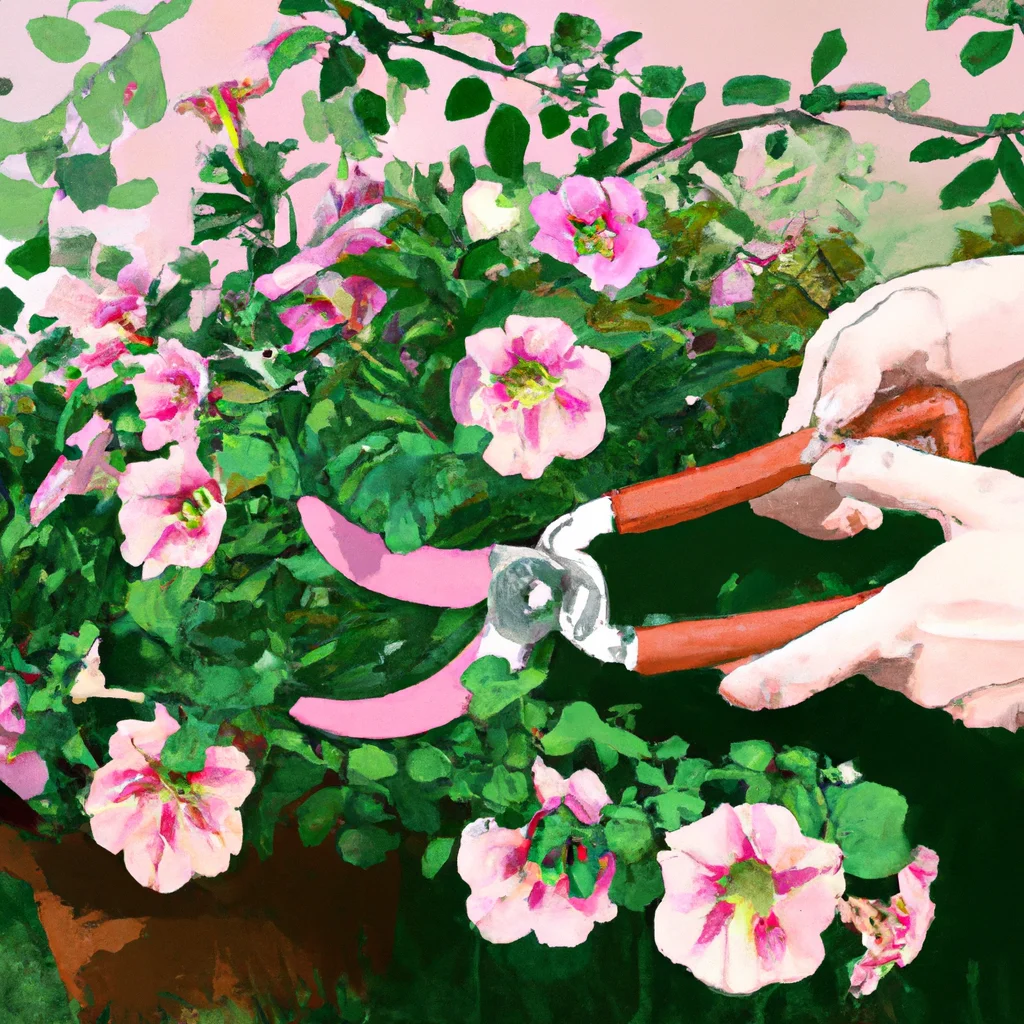Overview of calibrachoa pruning
Pruning is an essential part of calibrachoa maintenance. In order to keep these vibrant and delicate plants healthy, it is crucial to periodically remove dead blooms or leggy stems. Additionally, pruning will encourage bushier growth and promote a longer blooming period.
- Begin by assessing the plant’s growth habit. Consider its size and shape and determine which areas need attention.
- Use clean and sharp scissors or shears to remove any dead, dying or diseased foliage at the base of the stem. This will prevent diseases from spreading throughout the plant.
- Pinch back leggy stems or spent blooms to encourage branching and more compact growth. Make sure to cut just above a set of leaves, rather than leaving stubs.
- If necessary, prune back long stems by up to one-third of their length. Make sure to cut just above a set of leaves or nodes.
- Cut back the entire plant if it becomes too leggy or has stopped producing flowers. Trim the entire plant back by about half its height; this drastic measure can be done as many times as necessary during the growing season.
- Periodically fertilize your calibrachoa after pruning, following package directions carefully.
It is essential to remember that calibrachoa comes in various shapes and sizes– some may need more frequent pruning than others. Moreover, Spacing is another significant factor that determines how much You have to prune them — planting them too close together may require more frequent trimming.
Interestingly, Calibrachoa sometimes goes by its nickname Million Bells for famous reasons – it produces innumerable trumpet-shaped flowers that bloom uniformly throughout the summer months.
(Source: The Spruce)
When to prune calibrachoa? Whenever you need a break from staring at the plants and contemplating the futility of existence.
When to prune calibrachoa
Calibrachoa pruning is essential for its healthy growth and blooming. Proper timing of pruning determines the flowers’ yield and the plant’s subsequent quality. Before proceeding to prune, it’s essential to identify the calibrachoa variety you’re growing as some varieties require special attention.
Pruning calibrachoa is like giving your plants a haircut, except they can’t complain about the style.
How to prune calibrachoa
To prune calibrachoa effectively, you need proper guidance and a few tools. In order to master this technique, this section on “How to prune calibrachoa” with “Tools needed for pruning calibrachoa, Pruning techniques for calibrachoa, and Common mistakes when pruning calibrachoa” will provide you with a comprehensive solution.
Tools needed for pruning calibrachoa
Calibrachoa pruning requires specific tools that can ensure damage-free pruning. Here are some essential items for pruning calibrachoa:
- Pruning shears
- Gloves (preferably made of leather)
- Disinfectant solution
- Bucket of water
- Trowel or garden spade
It’s crucial to use the correct tools when it comes to calibrachoa pruning. Before beginning, ensure that the tools are clean and disinfected.
When trimming calibrachoa, consider removing dead leaves, wilted blooms, and any old growth regularly. It’s also crucial not to overshoot – a gentle prune is all that’s required for most plants.
Each plant’s natural shape could determine how much you should trim or pinch back. Optimal times for trimming are generally early spring before new growth emerges or midsummer after the blooms begin to fade.
Lastly, remember always to cut at an angle avoiding leaving stumps or jagged edges when cutting stem tips.
I once accidentally pruned too hard on my calibrachoa, causing multiple dead Zones on my plant 🙁 I learned it from trial and error that gentler was better.
Let’s give those calibrachoa plants a little haircut – it’s time to get them in shape!
Pruning techniques for calibrachoa
Calibrachoa, also known as Million Bells, requires pruning to maintain their shape and improve blooming. To cultivate healthy, abundant flowers follow these steps:
- Start by trimming dead or diseased foliage with pruners or scissors.
- Trim back the tips of the branches to encourage lateral growth and create a full plant.
- Pinch off spent blooms to promote continuous flowering throughout the growing season.
- Reduce the height and size of the plant by cutting back leggy stems halfway through summer.
To ensure maximum growth and health, it is important to prune Calibrachoa regularly. As you remove old blooms, you are encouraging new ones to take their place and enjoy prolonged blooming period.
Did you know that Calibrachoa was originally found in South America? It was discovered in Brazil by Japanese botanists who brought it back to Japan for hybridization before being introduced to North America. Today calibrachoa plants have evolved so much that they come in every shade except for blue!
Cutting too much of your calibrachoa can leave you with a plant that looks more like a bald eagle than a beautiful flower.
Common mistakes when pruning calibrachoa
Pruning calibrachoa requires finesse, as one small mistake can lead to stunted growth or disease. Here are Three steps to avoid Common errors when shaping blooms:
- Don’t cut too much: Over-pruning results in a less robust plant and fewer flowers
- Avoid shearing: Hand trim individual stems just above leaf axils for best results
- Timing is key: Prune early in the season to promote new growth and shape the plant correctly
When pruning calibrachoa, it’s vital to keep an eye out for pests and disease. Aphids, spider mites, and powdery mildew can all damage a plant if left untreated. Spraying plants with water or using natural insecticides can keep them healthy.
Calibrachoa is part of the Petunia family of plants. Pruning calibrachoa may seem like a chore, but trust me, the benefits are worth the snip!
Benefits of pruning calibrachoa
Pruning Calibrachoa: The Advantageous Reasons You Should Consider
Calibrachoa pruning brings a world of advantages to your gardening journey that may be overlooked.
- First, it improves the overall health of your plants by promoting growth and blooming by encouraging the development of new flowers.
- Second, it helps control size, preventing overgrowth and creating uniformity in plant appearance.
- Finally, pruning Calibrachoa adds beauty to your garden with the promotion of bushier and fuller plants.
It is also essential to note that pruning at the right time is crucial. Pruning too late may affect future growth.
Don’t Miss Out on the Benefits Of Pruning Your Calibrachoa! Include this simple process in your gardening routine to provide a healthier garden ambiance.
Your calibrachoa will thank you for the trim, but don’t expect a standing ovation.
Conclusion
After following the steps mentioned, it’s easy to prune Calibrachoa. In case of doubts or uncertainties, refer to the instructions for reassurance.
Remember, pruning helps in maintaining the plant’s health and aesthetics. Keep an eye out for dead parts, overgrowth, and pests and use sterilized tools for a successful operation.
Don’t miss out on adding this to your gardening routine as it results in healthy blooming and vibrant colors!
Frequently Asked Questions
1. When is the best time to prune calibrachoa?
The best time to prune calibrachoa is in late spring or early summer, after the first flush of blooms has faded.
2. How much should I prune my calibrachoa?
You should prune your calibrachoa back by about one-third to one-half, depending on how much growth you want to encourage.
3. What tools do I need to prune my calibrachoa?
You will need a pair of sharp pruning shears or scissors to make clean cuts without damaging the plant.
4. Should I prune my calibrachoa regularly?
Yes, regular pruning will help keep your calibrachoa healthy and promote new growth and blooming.
5. Can I prune my calibrachoa all year round?
No, you should only prune your calibrachoa during the growing season, which is typically from spring to fall.
6. How can I tell if my calibrachoa needs pruning?
If your calibrachoa is becoming leggy or overgrown, or if its blooms are starting to fade and die off, it may be time to prune it.

A passionate gardener and founder of ForTheLoveOfGardeners.com. She shares her expertise to help you cultivate thriving gardens and find joy in the beauty of nature.

